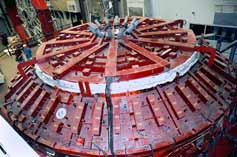
Handy Links
SLAC News Center
SLAC Today
- Subscribe
- Archives: Feb 2006-May 20, 2011
- Archives: May 23, 2011 and later
- Submit Feedback or Story Ideas
- About SLAC Today
SLAC News
Lab News
- Interactions
- Lightsources.org
- ILC NewsLine
- Int'l Science Grid This Week
- Fermilab Today
- Berkeley Lab News
- @brookhaven TODAY
- DOE Pulse
- CERN Courier
- DESY inForm
- US / LHC
SLAC Links
- Emergency
- Safety
- Policy Repository
- Site Entry Form

- Site Maps
- M & O Review
- Computing Status & Calendar
- SLAC Colloquium
- SLACspeak
- SLACspace
- SLAC Logo
- Café Menu
- Flea Market
- Web E-mail
- Marguerite Shuttle
- Discount Commuter Passes
-
Award Reporting Form
- SPIRES
- SciDoc
- Activity Groups
- Library
Stanford
Around the Bay
The LSST Gets Twelve Thumbs Up
 The Large Synoptic Survey Telescope (LSST)
has passed an important milestone on the way to becoming reality. An
NSF Conceptual Design Review of LSST progress—the first of three such reviews—occurred in September in Tucson, Arizona. Eighty members of the LSST Collaboration participated in the review. Observers from the
National Science Foundation (NSF), the Department of Energy (DOE) and European Southern Observatory, along with potential collaborators from Germany and France, were present. The 12 NSF reviewers were "very impressed," according to SLAC physics professor Rafe Schindler, who is part of the SLAC team designing the camera for the telescope and recommended the second NSF or Preliminary Design Review be conducted within 10 to 12 months.
The Large Synoptic Survey Telescope (LSST)
has passed an important milestone on the way to becoming reality. An
NSF Conceptual Design Review of LSST progress—the first of three such reviews—occurred in September in Tucson, Arizona. Eighty members of the LSST Collaboration participated in the review. Observers from the
National Science Foundation (NSF), the Department of Energy (DOE) and European Southern Observatory, along with potential collaborators from Germany and France, were present. The 12 NSF reviewers were "very impressed," according to SLAC physics professor Rafe Schindler, who is part of the SLAC team designing the camera for the telescope and recommended the second NSF or Preliminary Design Review be conducted within 10 to 12 months.
The LSST is designed to scan the skies of the Southern hemisphere repeatedly over a period of 10 years, looking for evidence of dark matter and dark energy, as well as mapping nearby asteroids and observing supernovae and other transient phenomena. If the project goes forward as planned, the 3.2 billion pixel camera used by LSST—by far, the largest digital camera ever made—will be assembled and tested at SLAC before being shipped to the telescope site in Chile.
Of the camera design, "A number of reviewers commented that they'd never seen an astronomical instrument engineered to this level of detail at this early a stage in the process," Schindler said. He credited the talented project scientists and engineers, and the strategic use of NSF, DOE and private R&D funding for the team's success. The LSST Corporation is a nonprofit organization, with 22 member institutions, funded in part by donors including the Keck Foundation and Google, as well as the NSF and the DOE.
Although the LSST is still in the research and development phase, the Corporation has generated funds to prototype the unique CCD sensors for the camera and to begin fabrication of the 8.4 m diameter mirror for the telescope. The University of Arizona's Steward Observatory Mirror Laboratory in Tucson will construct this mirror, a process which is beginning now and which will take six years to complete. The telescope is set to achieve first light in early 2014.
—Amber Dance, SLAC Today, October 9, 2007
Above image: This circular furnace will melt and spin-cast 38 tons of glass to create the LSST primary mirror.